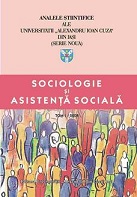IDENTITY AND GENDER EQUALITY IN ROMANIA A QUANTITATIVE ASSESSMENT FROM THE PERSPECTIVE OF THE 2030 AGENDA FOR SUSTAINABLE DEVELOPMENT
IDENTITY AND GENDER EQUALITY IN ROMANIA A QUANTITATIVE ASSESSMENT FROM THE PERSPECTIVE OF THE 2030 AGENDA FOR SUSTAINABLE DEVELOPMENT
Author(s): CIPRIAN IFTIMOAEI, Vicenţiu-Robert GaborSubject(s): Social Sciences, Sociology
Published by: Editura Universităţii »Alexandru Ioan Cuza« din Iaşi
Keywords: quality of life; women; gender equality; sustainable development; 2030 Agenda;
Summary/Abstract: The 2030 Agenda for Sustainable Development is the paradigm in which international organizations, UN member states, national, regional and local authorities act together to solve the concrete problems facing the world today. Although women and girls represent more than half of the world's population, they do not enjoy the same rights and freedom everywhere. The Sustainable Development Goal (SDG) 5 of the 2030 Agenda proposes to empower women by promoting equal opportunities for women and men around the world, facilitating women's access to education, training and careers, ensuring participation in political decision-making and in the management positions of companies, providing solutions to accommodate the time spent for childcare and family with the work schedule, preventing and combating all forms of violence against girls and women, improving their access to health and reproductive services. Starting from the targets and indicators associated with SDG 5, this study proposes a quantitative assessment of the quality of life of women in Romania. In this regard, we used data provided by Eurostat, the National Institute of Statistics, the National Commission for Strategy and Forecasting, as well as data from the reports of the National Agency for Equal Opportunities between Women and Men and the European Institute for Gender Equality. To verify the working hypotheses (research questions) we used descriptive statistical analysis with SPSS, Pearson correlation and linear regression processed with the XLSTAT program, graphical representation techniques with PHILCARTO software.
- Issue Year: 14/2021
- Issue No: 2
- Page Range: 171-198
- Page Count: 27
- Language: English

